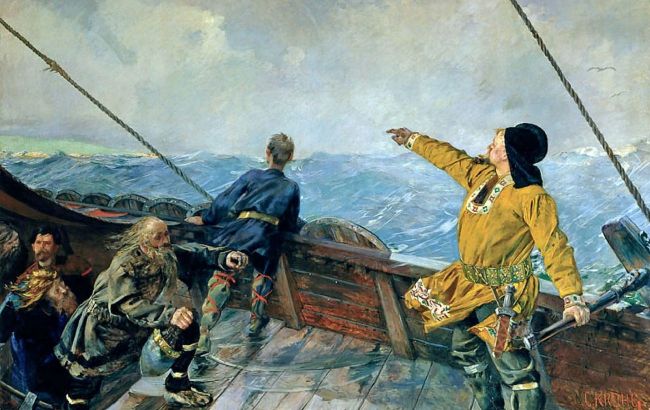Before Columbus - 8 travelers who could have discovered America
 "Leiv Eiriksson discovering America", painting by Christian Krohg (photo: Wikipedia)
"Leiv Eiriksson discovering America", painting by Christian Krohg (photo: Wikipedia)
For a long time, it was believed that America was discovered by Columbus, but new facts gradually emerged. They say that even before 1492, many travelers could reach this continent.
Vikings and their travels
The Vikings, known for their daring sea voyages, reached the shores of North America around 1000.
One of the first Vikings to land in the Americas was Leiv Eiriksson, son of the famous Eirik the Red. He named the new lands Vinland, which means "country of grapes," referring to the rich natural resources of these territories. There is archaeological evidence, including a settlement at L'Anse aux Meadows in Canada, that confirms the Viking presence in the Americas.
The Vikings were probably the first Europeans to reach the Americas long before Columbus, as their seafaring skills allowed them to travel long distances across the Atlantic Ocean. Most archaeologists agree that Vinland is located on the territory of modern Canada, southwest of the island of Newfoundland.
 Monument to Leiv Eiriksson in front of the Minnesota State Capitol (photo: Wikipedia)
Monument to Leiv Eiriksson in front of the Minnesota State Capitol (photo: Wikipedia)
Medieval Europeans
There are legends that Henry Sinclair, a Scottish nobleman, or J. V. Cortirial, a French navigator, may have traveled to the Americas before Columbus. Henry Sinclair, in particular, according to some historians, made an expedition to North America in the early fourteenth century, discovering new territories southwest of Greenland.
However, these theories lack sufficient evidence, so many scholars are skeptical. There is also a map by Giovanni Pizzigano, which is probably based on earlier sources, showing a group of islands in the Atlantic that were discovered only a few years after the map was drawn.
Although the evidence is not conclusive, it does point to the possibility of European travel to the Americas prior to Columbus' voyage.

Monument to the alleged landing site of the Sinclair Expedition, Canada (photo: Wikipedia)
Irish and Welsh travels
According to Irish legends, St. Brendan traveled across the Atlantic Ocean in the sixth century in search of the Isle of the Blessed. There are even different versions of this legend, where Brendan is described as the first European to reach America.
Another version, which belongs to Welsh legends, claims that Prince Madog ap Owain Gwynedd traveled to America as early as 1170. These legends were popularized in the 16th century when the British tried to prove their rights to new lands.
However, most researchers doubt the reality of these stories, and even the existence of Madog itself is controversial. Many modern scholars believe that these stories are more in line with folk beliefs than historical facts.
 Postage stamp "St. Brendan discovers Iceland" (photo: Wikipedia)
Postage stamp "St. Brendan discovers Iceland" (photo: Wikipedia)
Roman and Egyptian hypotheses
Some historians put forward theories about the Roman or Egyptian origin of contacts with the Americas. They assume that the Romans could have sent expeditions to the new world, attesting to this through certain artifacts. For example, the famous "ceramic head" from Calicutlauca, which resembles a Roman sculpture, was found in modern Mexico.
However, most archaeologists believe it to be a fake, and such claims are unlikely without proper evidence. In addition, scientists have also studied Roman frescoes that allegedly contained images of plants typical of the New World, but these theories have been refuted by botanists.
Thus, although there are certain theoretical assumptions, there is no convincing evidence of Roman or Egyptian contact with the Americas before Columbus.
 Egyptian papyrus boat (photo: Wikipedia)
Egyptian papyrus boat (photo: Wikipedia)
African and Chinese contacts
There are also hypotheses that Africans or Chinese may have reached the Americas before Columbus. Some researchers point to the similarities between Olmec stone heads and the anthropological type of blacks, suggesting that the Olmecs may have been Africans or that their culture is of African origin.
At the same time, theories emerged that the Mali Empire could have organized an expedition that successfully reached America. Such hypotheses were supported by some researchers, but these ideas were not widely accepted by the scientific community.
There have also been theories about Chinese sea voyages to the Americas in the fourteenth century, including the idea that Chinese sailors reached the shores of the Americas before Europeans. However, most historians are skeptical of these hypotheses, as the evidence is not supported by archaeological or historical findings.
 Mali's ruler and traveler Mansa Moussa on the world map (photo: Wikipedia)
Mali's ruler and traveler Mansa Moussa on the world map (photo: Wikipedia)
Sources: Listverse, History, Wikipedia.

